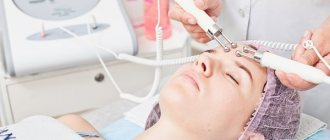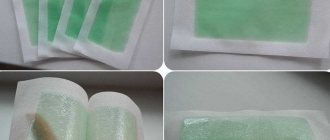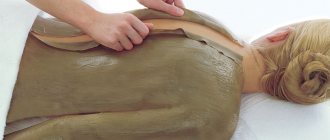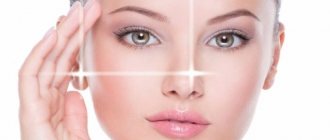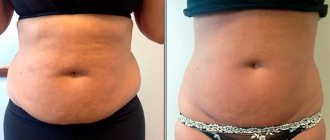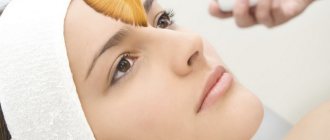Today, there are many means and methods for removing unwanted hair on the body, the most accessible of which are shaving, depilatory cream, and sugaring. Some of the methods lead to skin injury and do not bring long-term results.
One of the modern methods to get rid of vegetation is photoepilation. In this article we will talk about the procedure itself and preparation for it.
What is this procedure
To carry out home photoepilation, you will need to purchase a special device - a photoepilator. It is selected individually, based on the characteristics of the skin and hair.
Human hair consists of:
- follicle;
- root;
- rod.
They contain a special substance – melanin, which gives hair its color. The operating principle of the photoepilator is based on its ability to absorb light radiation and accumulate it in the bulb in the form of thermal energy. Under its influence, the hair structure is subsequently destroyed.
The intensity of light energy absorption depends on the melanin content in the hair - the more there is, the sooner it will be possible to remove unwanted hair. Coarse dark hair is removed most quickly, and it is completely impossible to remove gray, fluff and light hair using photoepilation.
Pay attention to this when choosing a photoepilator. It must emit a specific wavelength of light that will be most effectively absorbed by melanin. This selective effect is called selective (selective) hair removal.
Hair heating temperature
Photoepilators used in cosmetology heat the hair up to 800 C. Because of this, all the cells of the hair bulb (follicle) die, so its growth does not resume. When using a device of lower intensity, destruction of follicle tissue also occurs, but to a low degree.
Depilation using this method is effective when treating hair in the active growth phase. Since they appear on the surface of the body at different times, several sessions will be required for the skin to become completely smooth. Usually 5-12 procedures are enough; the exact number of trips to the salon can only be determined by a cosmetologist.
Using photoepilation, you can remove hair from almost any part of the body (except for the cases listed in the contraindications):
- armpit area;
- upper and lower limbs;
- bikini;
- stomach.
Only an experienced specialist can tell you how to do photoepilation correctly and effectively at home, so it is advisable to consult with him before the procedure.
Advantages and disadvantages
All cosmetic procedures for removing unwanted hair have pros and cons relative to each other. Hair removal using a photoepilator is no exception; it has the following advantages:
- the epidermis is not damaged, which reduces the risk of infection;
- After the manipulation there are no ingrown hairs - the follicles are completely destroyed.
Due to the fact that some of the hair follicles in the skin are in “sleep mode,” it is impossible to completely get rid of hair in one procedure. But visible results will be noticeable immediately after the first use.
Some of the positive side effects of light energy on the skin include:
- rejuvenation;
- smoothing out small wrinkles;
- healthy and fit appearance.
Before going for photoepilation, you should remember that it has the following disadvantages:
- It will take several sessions, so you need to have patience and money (if done in a beauty salon).
- It is not suitable for sensitive skin.
- Home hair removal involves the use of devices with low power, so complete removal of unwanted hair in one go is impossible.
- Facial hair growth in women is usually a consequence of hormonal imbalance. When epilating this area, it should be taken into account that it will not be possible to completely get rid of vegetation on it. It is also not recommended to irradiate it often - the skin there is thin and delicate, otherwise it will lead to sad consequences.
- It is ineffective in the fight against gray, weakened and melanin-deprived vegetation.
- With a low pain threshold, severe discomfort appears. Therefore, before doing photoepilation, you need to test the device on one area of the body.
Another disadvantage of the procedure is the ability of light radiation to degenerate some types of papillomas and moles into malignant neoplasms.
Reviews from women
I bought and have already used Phillips 6 times. I was on the verge of a hysterical attempt to get rid of a bunch of coarse and black hair. At this stage, I can say for sure: growth is definitely slowing down (in my case, 3 times), previously, after shaving in the morning by the evening there were already thorns, now 3-4 days of smooth skin, the amount has now decreased by 30-40%, and the hair has become at least a third thinner. The downside is that by the end of the second week between epilations, itchy, small pimples begin to appear, with hairs trying to break through. And in my case, the situation in the armpit area does not change in terms of quantity ((, in other places everything is very noticeable.
Katerina, Moscow
https://www.divomix.com/forum/fotoepilyaciya-na-domu-otzyvy-mify/
Hair still begins to grow within a few months. I quit going to salons and bought a home photoepilator. After a long search, I chose Silken Sensepil. Suitable for all areas, including bikini, the only drawback is that you need to buy lamps from time to time, but it’s still cheaper than in a salon. Another important point is that photoepilation is not suitable for fair skin.
Sveta
https://www.woman.ru/beauty/medley2/thread/3952371/3/
I will share my experience. Never try to do any hair removal on your face without consulting an endocrinologist or gynecologist-endocrinologist (he will even help better). I did it a couple of times and then everything only got worse.....First you need to get your hormones in order so that everything is normal. For me personally, the test for all male hormones was 3000, I think that’s not that much. And then the doctor will prescribe some additional tests and refer you to a physiotherapist. It’s even better to go to a physiotherapist; he is still a doctor, and not just a cosmetologist who indiscriminately treats your medical needs. cards will remove hair. So girls, be careful!
Martha
https://www.woman.ru/beauty/medley2/thread/3952371/3/
So, photoepilation is a fairly convenient, quick and, most importantly, painless way to permanently get rid of unnecessary hair on the body. However, not everyone can afford to buy such an expensive device. But if you calculate how much money, time, patience and effort goes into regular shaving, you can come to the conclusion that the cost of a photoepilator is not such a big amount. As the famous saying goes, beauty requires sacrifice. And financial sacrifice is just a temporary inconvenience. So, by deciding to spend once, you will forever gain smooth skin on all parts of your body.
- Author: woman
Rate this article:
- 5
- 4
- 3
- 2
- 1
(3 votes, average: 3.7 out of 5)
Share with your friends!
Side effects
Destruction of hair follicles during photoepilation occurs due to exposure to thermal energy. Therefore, with high skin sensitivity, the risk of burns increases. Most often it appears due to incorrect selection of light intensity or equipment malfunction. If the device is working properly, a burn may occur due to depilation at the wrong time: after prolonged exposure to the sun or during irritation.
Before doing photoepilation on large areas of the body, you should observe how the skin behaves after it. An allergic reaction to light flashes or post-epilation care products is possible.
When working with a photoepilator, you must take care of protecting your eyesight - light flashes impair vision.
How to choose a device
Photoepilators for home use are sold in consumer electronics stores. They are relatively inexpensive, but have a small range of light emission and, accordingly, have low efficiency. Before purchasing a device for personal use, you should weigh the pros and cons of photoepilation. To familiarize yourself with the procedure, it is recommended to conduct a trial hair removal session in a cosmetology office with a specialist.
When purchasing a photoepilator, pay attention to the following characteristics of the device:
- Power (selected based on the characteristics of the hair: thickness, color intensity). The correct value of this value for home use devices is from 3 to 5 J per 1 cm2.
- Area covered. The time it takes for the procedure depends on its value. Devices with a reading of up to 6 cm2 are suitable for hair removal at home.
- Flash speed. It should be about 2 seconds.
- Lamp quality. The higher it is, the longer the device will last without replacing the light emitter.
If you plan to use the photoepilator at home yourself, then you need to pay attention to the presence of a special UV filter. It will protect your skin and vision from the negative effects of light flashes.
In addition to the photoepilator itself and protective glasses, you will need to purchase a cooling gel and an antiseptic to disinfect the epilated areas.
Carrying out hair removal
Detailed information on how to use the photoepilator correctly and how to properly do photoepilation at home can be found in the device’s instruction manual. For additional information, it is advisable to contact a specialist - a certified cosmetologist who has experience working with such equipment. He will tell you how to do photoepilation at home so that all the negative aspects of it are minimized.
One of the main rules of photoepilation is regular sessions. How often you will need to use an epilator depends on the model of the device, its power and the individual characteristics of the body.
When testing a new device, it is enough to epilate a small area of skin in an easily accessible area - the armpits or lower legs. You should start with 1-2 flashes, setting the intensity of the emitter to a medium value. If there is no discomfort, then add power according to the instructions. During the trial procedure, do not lean the device too often - you can get burned.
It should be remembered that if there is no pain at all, then the power of the device is not suitable and there will be no effect from it. There should also be no pain that is too severe.
How many sessions will it take?
Typically, one course of photoepilation includes 8-15 sessions, the number of which depends on the area where the procedure is performed, as well as the structure and color of the vegetation itself.
If we talk about how often photoepilation can be done, cosmetologists recommend doing it once every 1-1.5 months. It is this regular implementation of the technique that will ensure effective hair removal results forever.
Keep in mind that after the first session you will notice results. After a few days, the hairs will begin to fall out and will only partially grow back.
Preparation
In order for the procedure to be successful, the skin is first prepared - a light peeling is done on the area to be epilated. If you don’t have special products at hand, a massage with honey or tomato puree will do. Hair that is too long is shaved off with a machine - its length should not exceed 2-4 mm.
Before starting the session, the working device is wiped with lint-free wipes - it must be clean from dust and free of streaks. Next comes a check for serviceability - almost all models of home photoepilators have a touch sensor. If the device is applied correctly, it will begin to emit a sound or light signal. After the flash, it repeats, notifying that the manipulation was successful.
The photoepilator is moved along a horizontal line so that flashes of light do not affect the same area several times. This will help avoid burns. When depilating a large area, you can switch to the sliding mode.
You should follow the instructions for using the photoepilator - some models require applying a protective gel to the skin during use. This will help make the procedure more comfortable and safer.
The time spent on one session depends on the condition of the hair. Basically, photoepilation at home, if you have the skill, takes a little time:
- legs – from 8-20 minutes;
- bikini area – 5-10 minutes;
- deep bikini – 20 minutes;
- armpits – 2-8 minutes.
When not to do photoepilation
Contraindications include:
- pregnancy, breastfeeding;
- pathologies of the cardiovascular and chronic diseases of the endocrine system;
- damage to the skin: burns, abrasions, cuts;
- You cannot remove hairs growing from a nevus - there is a risk of thermal burn;
- age up to 14 years.
Photoepilation is a low-traumatic method of removing unwanted hair, but it should be carried out with caution, carefully weighing the advantages and disadvantages. It is important to maintain a pause of several weeks between sessions - this will help reduce the negative effects of light radiation on unprotected skin.
Description of the method
Photoepilation - what is it? The technology refers to types of hair removal that not only remove hairs with follicles, but also ensure long-term preservation of the result for several years.
The effectiveness of photoepilation is based on the use of high-pulse light beams that affect the root system of vegetation. They are absorbed by the pigment melanin, which is found in all hair follicles and is responsible for hair growth. This reaction leads to a sharp heating of the bulb and its spontaneous destruction.
When completing the full course, hairs are removed from the treated area for several years, but sometimes you still have to undergo one-time sessions to enhance the effect of manipulation.
Skin care after the procedure
During photoepilation, the skin is minimally exposed to heat. After this, soothing creams or gels are applied to the epilated area. They help avoid irritation and redness. To prevent damage to the skin, it is recommended to avoid saunas, baths and prolonged exposure to the sun for several days.
When performing photoepilation at home, you should pay attention to the sensations - there should not be any significant discomfort. Otherwise, it is better to choose other methods of body hair removal.
Contraindications
Like any cosmetic procedure, photoepilation has its contraindications.
- The procedure can be carried out only 2-3 weeks after sea tanning or visiting a solarium. During this time, the skin is restored and burns do not occur.
- It is not used for people with diabetes mellitus, with heart pathologies, during exacerbation of chronic diseases, or with malignant neoplasms (especially on the skin).
- The procedure is contraindicated for pregnant and lactating women, as well as for those who have wounds, abrasions or tattoos at the site of photoepilation.

